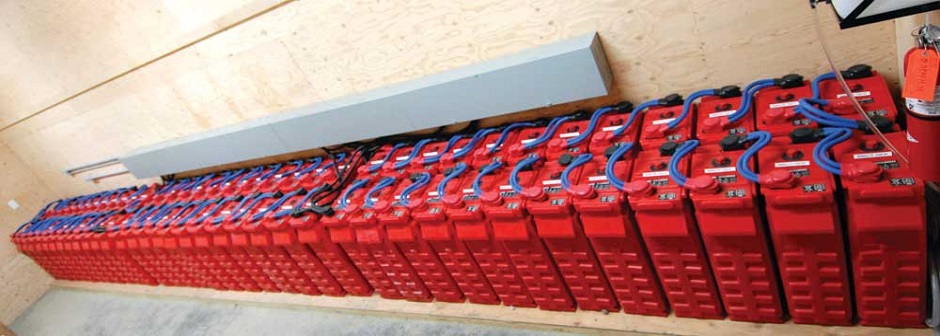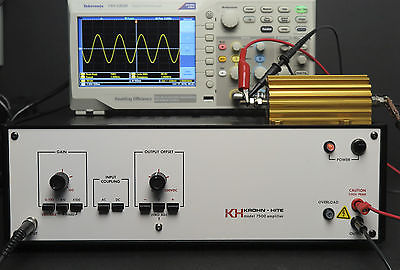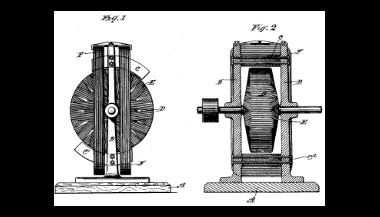Power

Lab-Tesla's Power Supply
All of the photography on this site showing Lab-Tesla infrastructure and equipment were either taken on site and show equipment that is physically present today, or generic photography was sourced depicting the identical model equipment that is physically present on site... With the exceptions of these two photos here: above, and below. Lab-Tesla has no batteries on site, these photos are just the dream. There is no power, I have been embezzzled out as of 7/22 - See the the front page credits for more information.
The Magic of Nikola Tesla
Tesla's magic was first in the development of his power supplies, followed by applications for those power supplies to create a viable technology... An example would be the alternating current generator, powered by a steam engine or water wheel, coupled electrically to the brushless induction motor. Tesla patented two DC generators BTW, US Patent 359,748 and US Patent 406,968, but his alternating current development was, and remains, not only historical, but economically mighty.
In the early 1890's Tesla embarked on a series of lectures where he introduced his newly developed "high-frequency" generators (see: US Patent 447,920 and US Patent 447,921); but to this day much, if not most, of the material in the lectures that Tesla presented, along with the technology and applications he demonstrated, has never been reproduced or duplicated. It is simply amazing that they were produced in the first place.
One of the biggest reasons why much of the advanced material that Tesla documented in lecture has never been duplicated or reproduced is that you cannot buy machines like US Patent 447,920 and US Patent 447,921 on Ebay. Tesla spent a large fortune in 1890's money having custom castings poured and machined, and the resulting generators while servicable, were not without problems: frequency stability and overheating were constant troubles, and on a bad day a machine might fly apart at high RPM and break stuff violently. With these two generator patents Tesla was pushing the physical limits of the iron shaft materials science of his day. Both of these machines produce electricity that alternates at a frequencies well above the range of human hearing, about 20 KHz, or 20,000 cycles per second; they were the power supplies used in Tesla's public lecture demonstrations and they were employed in secret as the power supplies for the first real radio transmitters.
Most of Tesla's research with energy was performed in a range of frequencies between DC, that is Direct Current having no frequency at all, to about 1 million cycles per second, or 1 MHz. Tesla liked to have a few horsepower of energy available in this frequency range or "band" for research, development, and demonstration purposes (there are 745.7 Watts per Horsepower); generators such as US Patent 447,920 were used for all three, and the technology was employed commercially in a system of soundless arc lighting for theaters.
The Lab-Tesla Signal Source

VOLTEQ SFG-1002
Lab-Tesla owns a new SFG-1002 Function Generator/Frequency Counter. This instrument is "wide-band" by Tesla research standards, it produces sine, triangle, and square wave functions over a range from 1 cycle per second to 2 million cycles per second. It is very low power, but as a signal source it is inexpensive, very accurate, and has a built in digital frequency counter.
Pre-Amplification

Krohn-Hite 7500
The Krohn-Hite 7500 [User Manual - Data Sheet] is designed to amplify the output of a function generator like the Volteq SFG-1002 up to a maximum frequency of 1 MHz, but with only 75 watts of output power at 100 KHz, dropping to only 10 watts at the maximum frequency of 1 MHz, it is quite weak by Tesla standards. The Krohn-Hite 7500 is sold as an output amplifier for research purposes, but in Lab-Tesla it only qualifies as a pre-amp, 75 Watts is only 1/10th of a Horsepower.
Amplification

3-500ZG Power Triode
The 3-500ZG power triode [Data Sheet] was originally designed as a "grounded-grid" amplifier tube and saw widespread commerical use in radio frequency amplifiers sold to amateur radio enthusiasts, as well as home built RF amplifiers. This tube has been used in everything from audio amplifiers to induction heaters, it is currently in production, and you can buy them all day in matched sets. The 75 Watt output of the Krohn-Hite 7500 is enough power to drive the grid on the 3-500ZG at frequencies up to about 400 KHz. At higher frequencies the output of the Krohn-Hite drops off, and the easiest solution to cover the "band" at these higher frequencies is to add a second Krohn-Hite 7500 in parallel with the first. For lower frequency work, things like Tesla's patented wireless motors, the existing Lab-Tesla inventory: Source Signal/Pre-Amp/Amp will provide a base line 750 Watts of output energy from the high-voltage anode of the 3-500ZG, and for short periods this power tube can nearly triple that output. So one 3-500ZG properly configured and operated can produce the several horsepower of energy that Tesla liked to have available for research, lecture demonstrations, and prototype development. This is a reasonable, modern, modular solution using off-the-shelf components to assemble a power supply to substitute for US Patent 447,920 that Tesla used in the lecture hall to demonstrate things like single wire motors, and wireless power transmission.
Tesla's Wireless Motor

Lab-Tesla Proprietary Research!
smh... Over 127 years ago, if I am counting backwards correctly, Tesla filed for, and received, patent protection on his wireless motor technology. The document that Lab-Tesla is referencing here is US Patent 424,036; Electro-Magnetic Motor; File Date May 20, 1889, Published Mar 25, 1890. Lab-Tesla has carefully examined every Tesla patent repeatedly, text and diagrams, with an eye searching out the most detailed minutiae. Our thorough background research has developed into a large body of proprietary information. Lab-Tesla is "skilled in the art". This motor; 424,036, is unique among all of the motors in Tesla's patent portfolio. This motor patent contains no wiring diagram; nor does it show any electrical terminals to connect to the power supply. The reason is that this motor does not need a wiring diagram, what you see is what you get, it is that simple; but other "simple" Tesla patented motors show the terminal connections on the motor mount: 424,036 shows neither wiring diagram or electrical terminals for connection to the power supply, because this is Tesla's wireless motor, a Lab-Tesla re-discovery. Being "skilled in the art" Lab-Tesla is very much aware that just because we publicly disclose Tesla's patented wireless motor technology, does not mean that anybody else will be able to make Tesla's wireless motors turn. The trick is in the power supply, and the transmitter geometry. Tesla documented the key elements of the power supply and transmitter geometry in other places, and Lab-Tesla feels that the best way to document and measure Tesla's wireless motor system is to construct and operate demonstration prototypes of this motor: Tesla included a simple, inexpensive, bench-top demonstration model in the patent (see: fig 3 in the linked patent) just for this purpose. Anybody with sheet metal shears can construct the demonstration model of this technology, but the person or lab that can make this motor turn will be creating a revolution, literally. That is Lab-Tesla's job.
Ion Drive for Electric Spacecraft

Lab-Tesla Proprietary Research!
Unlike Tesla's patented wireless motor, Lab-Tesla has developed working ion drive technology for electric spacecraft that has no patent protection. Nobody can patent Tesla's wireless motor, the patent has expired. We are publicly disclosing our knowledge of this motor as a demonstration of our deep understanding of Tesla's body of work. Nobody else in the world has identified Tesla's wireless motor patent, but once it is shown to you, the motor is easily constructed by anyone "skilled in the art". Lab-Tesla's Ion Drive technology is like that. We would love to publish detailed photo documentation of the construction and tuning of one of our ion drive motors, but when the cat is out of the bag, someone will make bank, and Lab-Tesla is very much under-funded for the level of research and development being performed. One of the reasons for the creation of the Lab-Tesla website in July of 2017 was to make public disclosures, with promises of additional disclosures as they are developed, in exchange for a reliable funding stream to support the lab. Lab-Tesla is owned and operated by a single person. Working in the lab generates a huge amount of research data, but the expenses are considerable and it does not pay for anything. Working at the Bad Rabbit Cafe washing dishes for $8.00 an hour pays the bills, keeps dry food in stock, and feeds the dogs, but it does not perform the research.
Lab-Tesla is investing in the future!
But Lab-Tesla Needs Your Support!
Since it's founding in 2007, Lab-Tesla has been entirely funded as an out-of-pocket expense by the owner/researcher Richard T. Quick II. After 10 years of R & D the lab needs, and deserves, a major upgrade. In the years prior, with background research uncompleted, it would have been foolish to solicit and spend research money, because without research results to advance, what exactly are you going to spend the money on? Don't know yet? Back to the books.
July, 2017 is a much different story. Lab-Tesla has completed it's background research project, you know, now, where Tesla's wireless motor is, but making this motor turn requires a specialized high-energy power supply, driving a specific transmitter geometry, and these are not to be found easily. In addition to the research and development of Tesla's wireless motor technology, Lab-Tesla has developed it's own ion-drive technology and is in posession of demonstration prototypes, but, once again... Operating the ion drive requires a specialized power supply.
In response to these developments and requirements, the owner quit the lab and took a job washing dishes for $8.00 an hour in order to develop a research budget. Off hours were spent researching available hardware to assemble a modular wide-band amplifier technology with a minimum rated output of about 750 Watts, or one Tesla Horsepower. At this point all of the components to assemble and operate this amplifier power supply are documented on this website, and this equipment is paid for and in posession of Lab-Tesla. Lab-Tesla is debt and lien free, and all laboratory inventory, building, and property is wholly owned by Richard T. Quick II.
Lab-Tesla is off-grid, located in an all metal, electrically grounded building, in the remote mountains in Big Bend, Texas. This location and construction was chosen both to keep operating expenses as low as humanly possible, and to prevent complaints about noise or radio frequency interference, all of which can be a serious problem in more densly populated areas. I have measured EMPs from laboratory experiments that travel right along the utility lines, Tesla has documented the same thing with the power lines coming into his Colorado Springs Laboratory. Serious research, even at low power levels should be conducted in isolation from power and data infrastructure that is woven throughout the civilized world. Up to this point, Lab-Tesla has operated with commerical internal combustion generator power supplies for high-power testing and shake-downs, and a small solar charged battery bank for instrumentation measurements and very low power testing of a few watts. At this point, after 10 years, everything is scrap value. I would pay someone to haul it off the property.
But today the modular amplifier components are here, and there is a cash budget saved up to pay for a significant upgrade of the solar power system, enough that Lab-Tesla can operate without combustion generators, not even a backup generator will be required on-site. This budget includes $1500 for a 5000 watt pure sine wave inverter to power the amplifier and instrumentation bench, and $1000 to pay for 600 watts of solar panels... But the batteries required to operate the lab at these power levels with the equipment and instrumentation documented on this site really start out at $5000, Tesla Motors wants almost $10,000 for a 5 KWH Powerwall when you add up the shipping, mounting hardware, cabling and other required infrastructure to support a high-energy battery pack.

